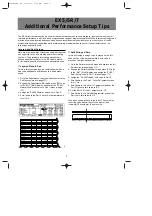
7
FILL-IN
Pressing this button
j
while a rhythm is playing, repro-
duces a rhythmic variation of the drums.
RECORD/PLAYBACK FUNCTION
This function enables you to record and playback a tune
played on the keyboard. Press REC.
g
before playing a
tune. When you have finished press PLAY
h
to listen to
the tune.
OKON - Learning function
The One Key One Note function allows easy playing of
the melody of one of the pre-recorded songs.
Press the OKON
k
button, choose the desired song by
pressing the corresponding white key (the accompani-
ment starts up), to perform the melody press any of the
keys in succession.
See the following figure for the position of the 6 demo
songs on the keyboard:
SINGLE (EASY CHORD)
With a rhythm on, by pressing the button SINGLE
l
the
keyboard is automatically divided into two sections, so
that the chords can be composed in the left part EASY
CHORD (from DO1 to FA#1) in facilitated mode with
one
,
two
or
three
fingers (see the chords table at the end of
this manual).
By pressing SYNC
l
before the SINGLE button, the
automatic accompaniment starts with rhythm 01.
PERCUSSION INSTRUMENTS
Pressing DRUM
m
enables 37 rhythmic percussions on
the white and black keys.
USING THE USB FLASH DRIVE
This keyboard enables you to read MP3 songs on a USB
Flash drive (Pen Drive) when it is connected to a USB
port at the back of the instrument
t
.
After connecting the device, the first song will automati-
cally start playing and will be heard from the speakers on
the keyboard. To adjust the volume, keep the MP3 VOL
button pressed (
or
)
f
; to pause the song,
press PAUSE / PLAY; to go to the next or previous song,
press MP3 VOL (
or
).
LABEL WITH STAVE AND NUMBERS
The front of the instrument features a label
q
to identify
the notes on the keyboard and on the stave. The names
of the notes are written in the international notation
system.
Numbers 1 to 15
indicate the keys to play a melody
with the musical scores at the end of this manual.
MODIFICATIONS
Sometimes, next to the
treble clef at the begin-
ning of the stave or next
to a single note, these
signs will appear: (flat)
or (sharp). These signs mean that all the notes on that
line, in that space or the single note itself are flat or sharp
notes, that is, they are to be played on the relevant black
keys. It’s easy to recognize them because of the method
with a number followed by the plus (+) sign. The
(bequadro) sign (natural) which you may find on the line
of the stave means that the previous (flat) or (sharp)
indications are to be cancelled.
HOW TO PLAY THE SONG IN EASY MODE
MELODY: In the following songs, each note corresponds
to a number, by looking at the keyboard you will see that
there is a number on the stave label. To play the melody,
follow the numerical sequence on each note and press
one after another the black and white keys corresponding
to the same numbers on the keyboard.
The correspondence
between the notes,
numbers and their posi-
tion on the keyboard is
given on the next dia-
gram.
CHORDS: The songs also indicate the chords for
accompaniment. The letters on the stave label are the
names of the notes used to form a chord (refer to the
chords table at the end of this manual).










































